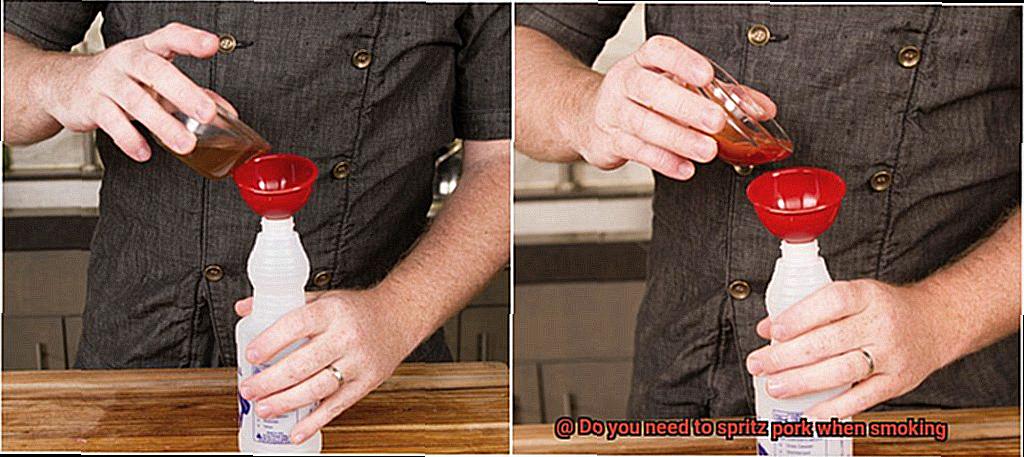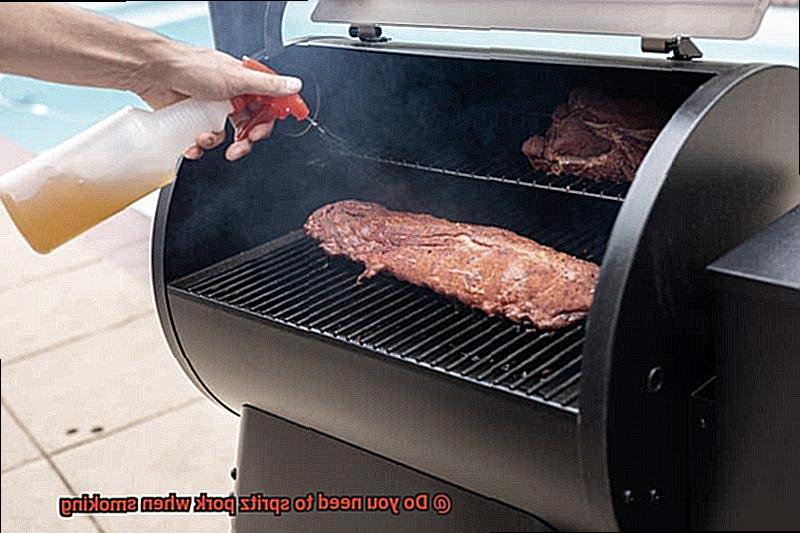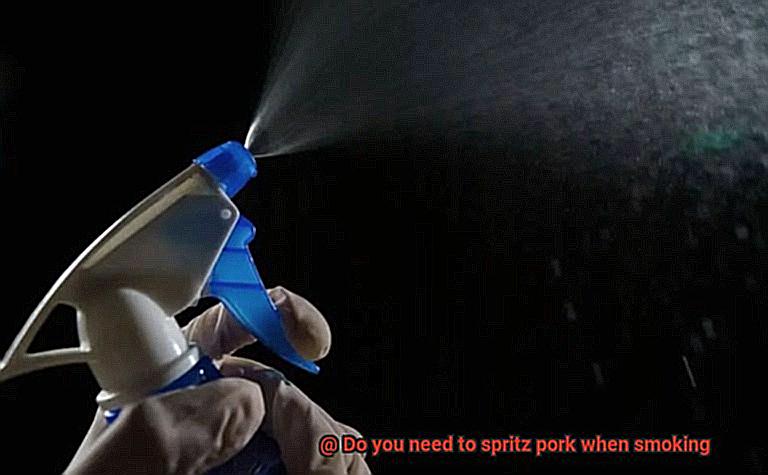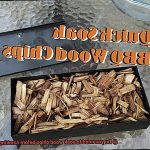Picture this: the mouthwatering aroma of slow-cooked pork wafts through the air as you eagerly anticipate your first bite. You’ve spent hours tending to your smoker, carefully monitoring the temperature and adding just the right amount of wood chips. But there’s one step in the process that has pitmasters and BBQ enthusiasts divided – to spritz or not to spritz?
Spritzing involves misting your meat with a liquid during the smoking process. It’s a popular technique used to keep meat moist, add flavor, and create that coveted bark on the outside. Apple juice, vinegar, beer – these are just a few of the liquids commonly used for spritzing pork.
But is it really necessary? Some swear by it, while others argue it’s an unnecessary extra step. In this blog post, we’ll dive into the science behind spritzing and explore alternative methods for achieving juicy, flavorful smoked pork.
So, whether you’re a seasoned pitmaster or a curious beginner, grab a cold beverage and join us as we unravel the mystery of pork smoking and spritzing.
Contents
Benefits of Spritzing Pork
Smoking pork is a time-honored tradition that requires patience and attention to detail. But what if we told you there was a technique that could take your pork smoking game to the next level? Enter spritzing, an essential technique that involves spraying the pork with a liquid during the smoking process. In this blog post, we’ll explore the numerous benefits of spritzing pork and how it can help you achieve perfectly cooked and delicious meat.
Firstly, moisture is key when it comes to smoking pork. Spritzing helps keep the meat moist and tender throughout the cooking process. Smoking meat for long periods can result in dry, tough, and chewy meat. By spraying the pork regularly with a liquid mixture, you can prevent this from happening and achieve juicy, mouth-watering meat.
Secondly, spritzing can enhance the flavor of the pork. The liquid mixture used for spritzing can contain various ingredients that add layers of taste to the meat. For example, apple juice adds a sweet and fruity flavor while apple cider vinegar adds a tangy and acidic taste. The possibilities are endless, experiment with different combinations to find your perfect flavor profile.
Thirdly, spritzing helps create an attractive appearance for the pork. The liquid mixture used for spritzing helps create a shiny and caramelized crust on the meat, which makes it more visually appealing. Impress your guests not just with the taste but also with the appearance of your perfectly cooked pork.
Lastly, spritzing helps regulate the temperature of the meat. When you spray the meat with a liquid mixture, it cools down slightly, preventing overcooking. This is particularly useful when smoking larger cuts of meat that require several hours of cooking time.
Different Liquids to Use for Spritzing
Then it’s time to up your game by incorporating the technique of spritzing. This process involves spraying a liquid onto the pork during smoking to keep it moist, enhance its taste, and create an attractive outer crust. But with so many options available for spritzing liquids, it can be challenging to decide which one to use. As an expert on this topic, let me guide you through the different liquids you can use to elevate your pork smoking experience.
First off, we have the classic choice of apple juice or apple cider vinegar. This option gives the meat a slight sweetness and tanginess that is hard to resist. Additionally, it has tenderizing properties that will leave your pork juicy and flavorful.
Next on our list is a mixture of water and Worcestershire sauce. The combination adds a savory, umami flavor to the meat that will tantalize your taste buds. It’s an excellent option for those who prefer less sweetness in their pork.

For those feeling adventurous, try using beer or other alcoholic beverages for spritzing. These liquids infuse additional flavors and aromas into the meat. However, remember that alcohol evaporates quickly and may not provide as much moisture as other options.
Fruit juices like pineapple or orange juice are a perfect choice for those looking for a tropical twist in their pork. These juices add a unique flavor to the meat that will make it stand out from the rest.
Believe it or not, some people even use cola or other soft drinks for spritzing. This unconventional option adds a sweet and slightly acidic flavor that pairs well with pork.
It’s crucial to remember not to go overboard when spritzing your pork. Too much liquid can wash away any rub or seasoning on the meat and dilute its flavor. A light spritz every 30-45 minutes during smoking should be sufficient to keep the meat moist and flavorful without overpowering it with liquid.
How to Spritz Pork When Smoking
When it comes to smoking pork, keeping the meat moist and flavorful can be a challenge. That’s where spritzing comes in. Spritzing involves spraying the pork with a liquid during the smoking process to add moisture and flavor.
The first step in spritzing your pork is choosing the right liquid. Apple juice, cider vinegar, and beer are popular choices that complement the pork’s flavor without overpowering it. Make sure your spray bottle or mister is filled with your desired liquid before starting.
During the smoking process, it’s important to spritz quickly and efficiently to prevent too much heat from escaping from the smoker. Open the smoker door as little as possible and spray the liquid evenly over the surface of the pork. Be careful not to oversaturate the meat as this can create a soggy texture.
Spritzing can be done every 30 minutes to an hour, depending on how quickly the meat is cooking and how much moisture it needs. It’s essential to monitor the internal temperature of the pork using a meat thermometer to ensure safe consumption.

While spritzing can enhance the flavor and moisture of smoked pork, it’s not necessary for successful results. Some pitmasters prefer not to spritz their pork and instead use rubs or marinades. Remember, it ultimately comes down to personal preference and experimentation.
Pros and Cons of Spritzing Pork
As an expert on the pros and cons of spritzing pork, I’m here to guide you through this game-changing technique.
First, the pros: Spritzing keeps your pork moist and tender throughout the smoking process. The liquid, usually apple cider vinegar or apple juice, locks in moisture resulting in a juicy and succulent final product. Not only does it help with moisture, but spritzing also adds a delicious sweet tanginess to your pork. You can even customize your spritzing liquid with spices or rubs for an extra boost of flavor.
However, there are some potential cons to keep in mind. First, be mindful that spritzing can cool down the surface of the meat, leading to longer cooking times. Additionally, if you spritz too often, you risk creating a mushy exterior texture. Lastly, watch out for oversaturating the meat with liquid as it may wash away some of the fantastic seasoning you added earlier.
Tips for Optimal Results When Spritzing Pork
Smoking pork is a labor of love that requires patience and skill. While there are many techniques to achieve optimal results, spritzing has become a popular method among pitmasters. This technique involves spraying a liquid mixture onto the pork during the smoking process to help keep it moist and add flavor.
To achieve the best results when spritzing pork, consider the following tips:
- Choose Your Liquid Mixture Carefully: The liquid mixture used for spritzing can significantly impact the final flavor of the meat. Some popular options include apple juice, vinegar, or even a combination of spices. Experiment with different mixtures to find what works best for your taste preferences.
- Start Spritzing Early: It’s essential to start spritzing early in the smoking process to ensure that the meat stays moist from the beginning. Aim to start spritzing after the first hour of smoking.
- Spritz Regularly and Evenly: To maintain moisture and flavor throughout the smoking process, it’s important to spritz regularly and evenly. Aim to spritz every 30 minutes or so, and make sure to cover all parts of the meat with the liquid mixture.
- Avoid Over-Spritzing: While spritzing can be helpful, too much liquid can wash away the rub or crust on the outside of the meat. This can affect the final texture and flavor, so it’s crucial not to overdo it.
- Adjust Spritzing Frequency Based on Cooking Time: Depending on how quickly the pork is cooking, adjust your spritzing frequency accordingly. If it’s cooking quickly, it may not need to be spritzed as often. On the other hand, if it’s taking longer than expected, more frequent spritzing may be necessary to keep it moist.
Alternatives to Spritzing Pork
Spritzing is a popular technique to keep meat moist and add flavor, but it may not be suitable for everyone. If you’re looking for alternatives, you’ve come to the right place. Fortunately, there are several ways to achieve juicy, tender, and flavorful smoked pork without spritzing.
One option is the Texas Crutch, a method that involves wrapping the pork in foil or butcher paper once it reaches a certain temperature. This technique traps moisture and speeds up cooking time while infusing flavor into the meat. If you’re short on time or looking for a simpler cooking process, give the Texas Crutch a try.
Another alternative is to use marinades or injections before smoking the pork. This technique allows for deeper penetration of flavors into the meat without the need for constant spritzing. You can create a simple injection using apple cider vinegar, apple juice, garlic, and onion powder. This method is perfect for adding flavor without constantly monitoring your pork.
Using a water pan in the smoker is also an excellent way to keep the pork moist and tender. The water pan adds moisture to the air and prevents the meat from drying out during longer smoking sessions. This method is particularly useful if you don’t want to open the smoker frequently and lose heat.
Best Cuts of Pork to Spritz
Smoking pork is an art that requires attention to detail, and spritzing is a technique that can elevate your game. This process involves lightly misting the meat with a liquid during the smoking process to keep it moist and enhance its flavor. However, not all cuts of pork benefit equally from spritzing.
The top cuts of pork to spritz are those with higher fat content and connective tissue, such as pork shoulder or Boston butt. These cuts are favorites among smokers because they are ideal for low and slow cooking. While they have enough fat to keep them moist during the smoking process, spritzing can help to enhance their flavor and prevent them from drying out. Plus, since pork shoulder is often used for pulled pork, spritzing can help break down the fibers and make it even more tender.
Pork ribs are another cut that benefits from spritzing. Whether you prefer baby back or spare ribs, spritzing can help prevent them from drying out and give them a nice glaze. This is especially important if you’re using the dry rub method, which doesn’t rely on a sauce to keep the meat moist.
While leaner cuts like pork loin and tenderloin don’t have as much fat or connective tissue as pork shoulder or ribs, they still benefit from spritzing. Spritzing can be a great way to add some extra flavor to these cuts without adding unnecessary calories. For instance, you can mix apple juice and cider vinegar for a tangy spritz that complements the natural sweetness of pork.
Common Mistakes to Avoid When Spritzing Pork
Spritzing pork while smoking is an art form that can elevate your meat to new heights. It’s a technique that many pitmasters use to keep the meat moist and add flavor. However, there are some common mistakes that people make when spritzing pork that can negatively affect the final product.
One of the most common mistakes is using too much liquid in the spritz. While it is important to keep the meat moist, too much liquid can wash away the rub and marinade and dilute the flavor. It can also cause the meat to cook unevenly and lead to undercooked or overcooked areas. To avoid this mistake, stick to a light misting of your chosen liquid.
Another mistake is spritzing too often. While it may seem like a good idea to continually spritz the meat, doing so too often can cause the temperature inside the smoker to fluctuate, resulting in uneven cooking and potentially drying out the meat. Aim for spritzing once every hour or so to give your meat the moisture it needs without compromising its cook.
Using the wrong type of liquid for the spritz is another common mistake. Some liquids, such as fruit juices or apple cider vinegar, can add flavor to the meat, while others, such as water or beer, may not have as much of an impact. It is important to choose a liquid that complements the flavors in the rub and marinade. Experiment with different liquids until you find what works best for you.
Not properly covering the meat after spritzing is also a mistake. The liquid from the spritz can evaporate quickly, leaving the meat dry. It is important to cover the meat with foil or butcher paper after spritzing to trap in moisture and allow the flavors to penetrate.
rhjkeH9NCCo” >
Conclusion
In conclusion, spritzing pork during the smoking process can make or break your meat. On one hand, spritzing can help keep the pork moist, add flavor, create a visually appealing exterior, and regulate temperature. On the other hand, overspritzing can turn your meat into a soggy mess and wash away all of your carefully crafted seasoning.
Luckily for us, there are alternatives to spritzing that can yield equally delicious results. The Texas Crutch method, marinades or injections, and water pans in smokers are all great options to consider.
If you do choose to spritz your pork, it’s important to choose your liquid mixture wisely. Popular choices include apple juice or cider vinegar for a sweet tanginess; water and Worcestershire sauce for savory umami flavor; beer or other alcoholic beverages for additional aromas and flavors; fruit juices like pineapple or orange juice for tropical twists; and even soft drinks like cola for sweetness.
To achieve optimal results when spritzing pork, start early in the smoking process and spritz regularly without oversaturating the meat with liquid. Adjust your spritzing frequency based on cooking time and be sure to properly cover the meat after each misting session. This will trap in moisture and allow flavors to penetrate deeply into the meat.
When it comes to common mistakes to avoid while spritzing pork, remember not to overspritz or use too much liquid in the misting process. Doing so can cause temperature fluctuations inside the smoker leading to uneven cooking while using the wrong type of liquid may not have much impact on flavor.






